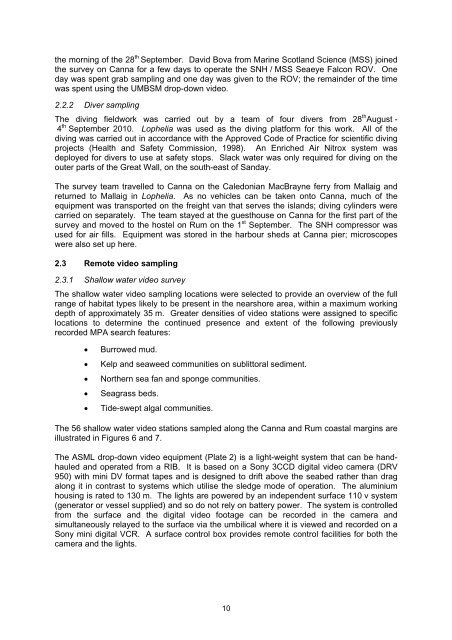Marine biological survey to establish the distribution and status of ...
Marine biological survey to establish the distribution and status of ...
Marine biological survey to establish the distribution and status of ...
You also want an ePaper? Increase the reach of your titles
YUMPU automatically turns print PDFs into web optimized ePapers that Google loves.
<strong>the</strong> morning <strong>of</strong> <strong>the</strong> 28 th September. David Bova from <strong>Marine</strong> Scotl<strong>and</strong> Science (MSS) joined<br />
<strong>the</strong> <strong>survey</strong> on Canna for a few days <strong>to</strong> operate <strong>the</strong> SNH / MSS Seaeye Falcon ROV. One<br />
day was spent grab sampling <strong>and</strong> one day was given <strong>to</strong> <strong>the</strong> ROV; <strong>the</strong> remainder <strong>of</strong> <strong>the</strong> time<br />
was spent using <strong>the</strong> UMBSM drop-down video.<br />
2.2.2 Diver sampling<br />
The diving fieldwork was carried out by a team <strong>of</strong> four divers from 28 th August -<br />
4 th September 2010. Lophelia was used as <strong>the</strong> diving platform for this work. All <strong>of</strong> <strong>the</strong><br />
diving was carried out in accordance with <strong>the</strong> Approved Code <strong>of</strong> Practice for scientific diving<br />
projects (Health <strong>and</strong> Safety Commission, 1998). An Enriched Air Nitrox system was<br />
deployed for divers <strong>to</strong> use at safety s<strong>to</strong>ps. Slack water was only required for diving on <strong>the</strong><br />
outer parts <strong>of</strong> <strong>the</strong> Great Wall, on <strong>the</strong> south-east <strong>of</strong> S<strong>and</strong>ay.<br />
The <strong>survey</strong> team travelled <strong>to</strong> Canna on <strong>the</strong> Caledonian MacBrayne ferry from Mallaig <strong>and</strong><br />
returned <strong>to</strong> Mallaig in Lophelia. As no vehicles can be taken on<strong>to</strong> Canna, much <strong>of</strong> <strong>the</strong><br />
equipment was transported on <strong>the</strong> freight van that serves <strong>the</strong> isl<strong>and</strong>s; diving cylinders were<br />
carried on separately. The team stayed at <strong>the</strong> guesthouse on Canna for <strong>the</strong> first part <strong>of</strong> <strong>the</strong><br />
<strong>survey</strong> <strong>and</strong> moved <strong>to</strong> <strong>the</strong> hostel on Rum on <strong>the</strong> 1 st September. The SNH compressor was<br />
used for air fills. Equipment was s<strong>to</strong>red in <strong>the</strong> harbour sheds at Canna pier; microscopes<br />
were also set up here.<br />
2.3 Remote video sampling<br />
2.3.1 Shallow water video <strong>survey</strong><br />
The shallow water video sampling locations were selected <strong>to</strong> provide an overview <strong>of</strong> <strong>the</strong> full<br />
range <strong>of</strong> habitat types likely <strong>to</strong> be present in <strong>the</strong> nearshore area, within a maximum working<br />
depth <strong>of</strong> approximately 35 m. Greater densities <strong>of</strong> video stations were assigned <strong>to</strong> specific<br />
locations <strong>to</strong> determine <strong>the</strong> continued presence <strong>and</strong> extent <strong>of</strong> <strong>the</strong> following previously<br />
recorded MPA search features:<br />
<br />
<br />
<br />
<br />
<br />
Burrowed mud.<br />
Kelp <strong>and</strong> seaweed communities on sublit<strong>to</strong>ral sediment.<br />
Nor<strong>the</strong>rn sea fan <strong>and</strong> sponge communities.<br />
Seagrass beds.<br />
Tide-swept algal communities.<br />
The 56 shallow water video stations sampled along <strong>the</strong> Canna <strong>and</strong> Rum coastal margins are<br />
illustrated in Figures 6 <strong>and</strong> 7.<br />
The ASML drop-down video equipment (Plate 2) is a light-weight system that can be h<strong>and</strong>hauled<br />
<strong>and</strong> operated from a RIB. It is based on a Sony 3CCD digital video camera (DRV<br />
950) with mini DV format tapes <strong>and</strong> is designed <strong>to</strong> drift above <strong>the</strong> seabed ra<strong>the</strong>r than drag<br />
along it in contrast <strong>to</strong> systems which utilise <strong>the</strong> sledge mode <strong>of</strong> operation. The aluminium<br />
housing is rated <strong>to</strong> 130 m. The lights are powered by an independent surface 110 v system<br />
(genera<strong>to</strong>r or vessel supplied) <strong>and</strong> so do not rely on battery power. The system is controlled<br />
from <strong>the</strong> surface <strong>and</strong> <strong>the</strong> digital video footage can be recorded in <strong>the</strong> camera <strong>and</strong><br />
simultaneously relayed <strong>to</strong> <strong>the</strong> surface via <strong>the</strong> umbilical where it is viewed <strong>and</strong> recorded on a<br />
Sony mini digital VCR. A surface control box provides remote control facilities for both <strong>the</strong><br />
camera <strong>and</strong> <strong>the</strong> lights.<br />
10

















